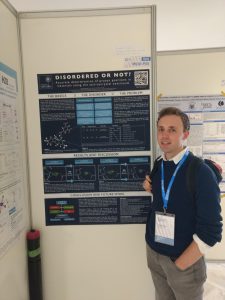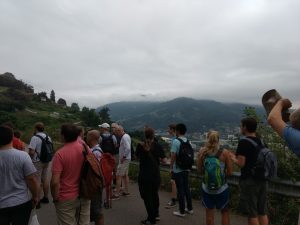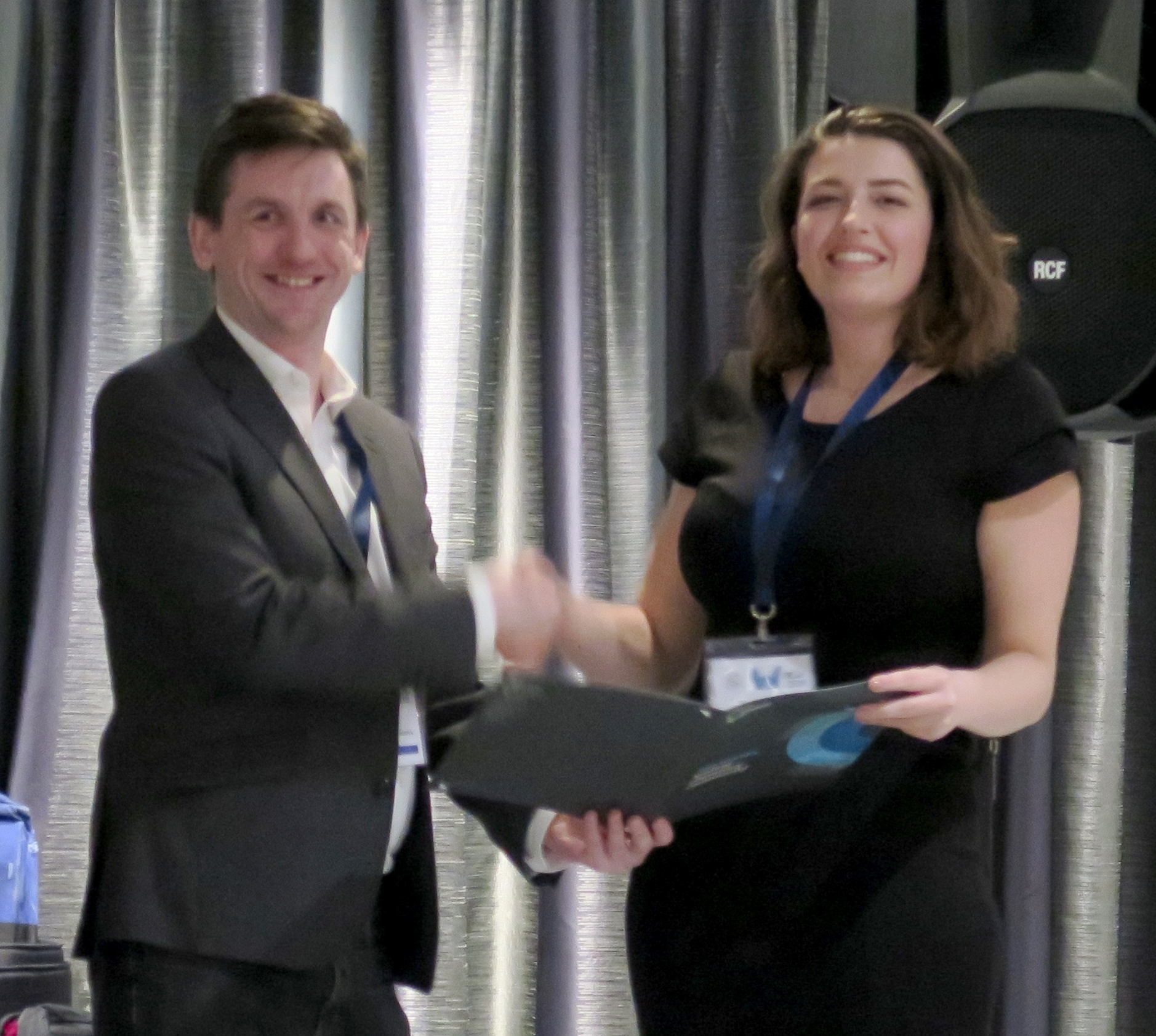
Georgia is investigating the occurence of modulation and the effects of radiation damage in a series of analogues of Barluenga’s reagent.

Georgia is investigating the occurence of modulation and the effects of radiation damage in a series of analogues of Barluenga’s reagent.
Chemical Communications 2018, 54, 9849 – 9852 [doi:10.1039/C8CC05430D]
For the collidine analogues of Barluenga’s Reagent (IPy2BF4) reported, a flat cation is necessary for the generation of a modulated phase, in keeping with the “Ratchet Model” theory [Kim et al., Crystal Growth & Design, 2014, 14, 6294]. Attempts to study “diffuse modulation” in Br(Coll)2ClO4 have shown that these non-Bragg features disappear very rapidly on exposure to synchrotron radiation, an effect thought to be caused by the radiation damage disrupting the lattice vibrations that cause the modulation.
The 31st European Crystallography Meeting was held in Oviedo, Spain from 22-26 August 2018.
 During the meeting George Sackman presented a poster (MS10-P05) on recent neutron diffraction work with Richard Cooper and Alison Edwards: Disordered or not: A cautionary tale when inferring proton disorder solely from X-ray and computational data.
During the meeting George Sackman presented a poster (MS10-P05) on recent neutron diffraction work with Richard Cooper and Alison Edwards: Disordered or not: A cautionary tale when inferring proton disorder solely from X-ray and computational data.
Richard Cooper gave a presentation (GI-MS47-O5) in the Saturday afternoon session How to… take your next steps in crystallography, based on experience of a career which despite including several areas of science and organisations rarely strayed outside the OX postcode.
On Sunday afternoon Amber Thompson presented (MS27-O5) Adventures in modulation: derivatives of Barluenga’s reagent, including work from Lewis Morgan, Yejin Kim, Emma McKinley, Jack Blandy, Claire Murray and Kirsten Christensen, in the session Quasicrystals: theory and
experiment.

Prior to the meeting, Richard Cooper was a tutor at the ECA Crystallographic Computing School in Mieres, organised by the ECA SIG 9 and gave a lecture on Programming Crystallographic Symmetry.
 The 2018 Meeting of the British Crystallographic Association was held at Warwick University where Chem. Cryst. was well represented. The meeting started with the Young Crystallographers Satellite meeting, during which Lewis Morgan’s oral presentation was so “eggsellent” that he won the Industrial Group Prize for the best talk, and with it, the dubious honour of presenting it again as a plenary in the main meeting.
The 2018 Meeting of the British Crystallographic Association was held at Warwick University where Chem. Cryst. was well represented. The meeting started with the Young Crystallographers Satellite meeting, during which Lewis Morgan’s oral presentation was so “eggsellent” that he won the Industrial Group Prize for the best talk, and with it, the dubious honour of presenting it again as a plenary in the main meeting.
At the conference dinner Kiaora Tolmie received a CCG CrystEngComm poster prize for her poster on hard-to-crystallize materials, and James Bird was awarded the YCG I’m-a-scientist-get-me-out-of here prize for the poster presenter who most clearly and enthusiastically communicated their results.
Congratulations to all three winners!
A full list of the presentations from Chem. Cryst.:
George A. Sackman & Richard I. Cooper
Distinguishing Disorder: A Molecular Dynamics Approach (Poster Presentation)
Kiaora L. M. Tolmie & Richard I. Cooper
Structure Determination of Hard-to-Crystallize Materials (Poster Presentation)
Lewis C. F. Morgan, Jack N. Blandy, Claire A. Murray, Kirsten E. Christensen & Amber L. Thompson
Improving Our Understanding of Modulation in Molecular Materials (Poster & Oral Presentation)
James M. Bird & Richard I. Cooper
A Comparison of Molecular Dynamics Techniques for Simulation of Thermal Disorder in Molecular Crystals (Poster Presentation)
Oliver J. A. Bar & Richard I. Cooper
A Study of Phase Transitions in Organic and Metal-organic Inclusion Complexes through Molecular Dynamics Simulation (Poster Presentation)
Richard I. Cooper
CrysPy: CRYSTALS in Python (Poster Presentation)
Amber L. Thompson
When are Bad Data Good Data? (Keynote Oral Presentation)